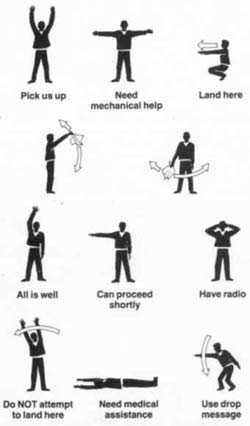
Warning
Care must be taken if you are going to 'practice' any sort of rescue signal that there is no possibility of them being mistaken for a 'real' signal.
Under no circumstances should the emergency services have to respond to a 'non-emergency'. This could ultimately cost lives.
Ground to Air Signals
| V | X | N | Y | ↑ |
| Require Assistance | Require Medical Assistance | No or Negative | Yes or Affirmative | Proceeding in this direc |
Sending and Receiving Signals
These are commonly used body signals that will be understood by airmen. Make sure that all signals are made clearly, exaggerate the movements and use a cloth to make the yes and no signals clear.
A pilot receiving messages from the ground will acknowledge receipt of these messages by:
Message received and understood
In daylight: flying the plane and tipping the wings in a rocking motion from side to side
At night: flashing green lights
Message received but NOT understood
In daylight: flying the plane in a right-handed circle
At night: flashing red lights
Mountain Rescue
These are internationally recognized by all mountain rescue services.
| Message | Flare Signal | Sound Signal | Light Signal |
|---|---|---|---|
| SOS | Red | 3 short blasts, 3 long, 3 short Repeat after 1 minute interval | 3 short flashes, 3 long, 3 short Repeat after 1 minute interval |
| Help Needed | Red | 6 blasts in quick succession Repeat after 1 minute interval | 6 flashes in quick succession Repeat after 1 minute interval |
| Message Understood | White | 3 blasts in quick succession Repeat after 1 minute interval | 3 flashes in quick succession Repeat after 1 minute interval |
| Return to Base | Green | Prolonged succession of blasts | Prolonged succession of flashes |
